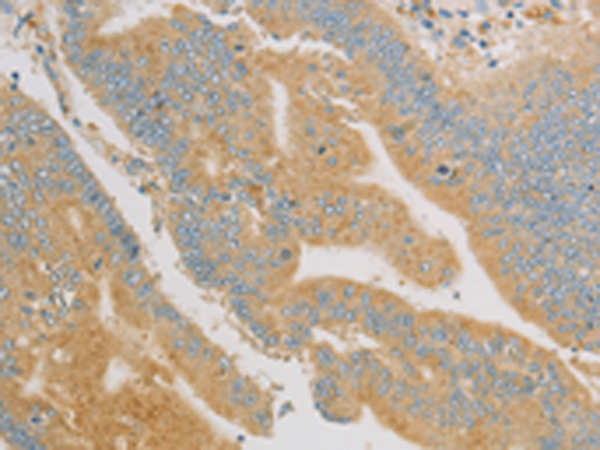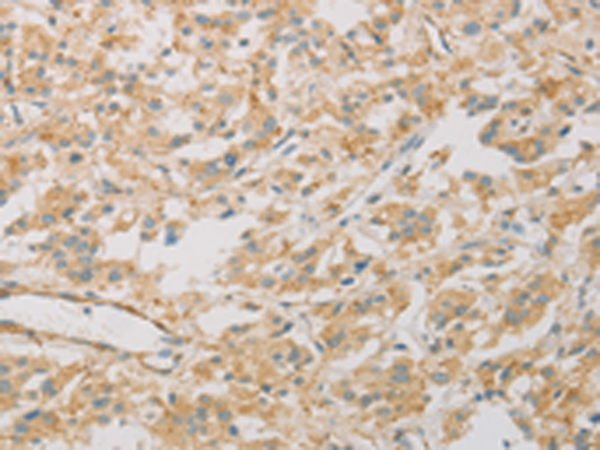

| WB | 咨询技术 | Human,Mouse,Rat |
| IF | 咨询技术 | Human,Mouse,Rat |
| IHC | 1/25-1/100 | Human,Mouse,Rat |
| ICC | 技术咨询 | Human,Mouse,Rat |
| FCM | 咨询技术 | Human,Mouse,Rat |
| Elisa | 1/2000-1/5000 | Human,Mouse,Rat |
| Aliases | ZNF393; Zfp393; RP4-675G8.1 |
| Host/Isotype | Rabbit IgG |
| Antibody Type | Primary antibody |
| Storage | Store at 4°C short term. Aliquot and store at -20°C long term. Avoid freeze/thaw cycles. |
| Species Reactivity | Human |
| Immunogen | Fusion protein of human KLF17 |
| Formulation | Purified antibody in PBS with 0.05% sodium azide and 50% glycerol. |
+ +
以下是关于KLF17抗体的3篇代表性文献摘要(虚构示例,仅作格式参考):
---
1. **文献名称**: *KLF17 suppresses epithelial-mesenchymal transition and metastasis in breast cancer*
**作者**: Gumireddy, K., et al.
**摘要**: 研究揭示了KLF17作为转移抑制因子的功能,通过调控ZEB1等靶基因抑制乳腺癌细胞的EMT过程。使用KLF17抗体进行免疫沉淀和染色,证实其在低转移癌细胞系中高表达。
2. **文献名称**: *KLF17 interacts with Nanog to maintain pluripotency in embryonic stem cells*
**作者**: Jiang, J., et al.
**摘要**: 通过KLF17抗体的ChIP-seq分析,发现KLF17与Nanog协同结合多能性相关基因启动子,调控胚胎干细胞的自我更新,敲低KLF17导致分化标志物显著上调。
3. **文献名称**: *DNA methylation-dependent regulation of KLF17 in lung cancer progression*
**作者**: Huang, L., et al.
**摘要**: 研究利用KLF17抗体进行组织芯片分析,发现KLF17启动子高甲基化与其表达缺失相关,恢复KLF17表达可抑制肺癌细胞侵袭,提示其表观遗传沉默在肿瘤中的作用。
---
如需具体文献,建议通过PubMed或Google Scholar以“KLF17 antibody”或“KLF17 function”为关键词检索,并筛选涉及该抗体实验(如WB、IHC、ChIP)的研究。
The Krüppel-like factor 17 (KLF17) is a member of the Krüppel-like transcription factor family, characterized by conserved C-terminal zinc finger domains that mediate DNA binding. KLF17 acts as a transcriptional repressor, playing critical roles in regulating gene networks involved in cellular differentiation, proliferation, and metastasis. It is particularly noted for its tumor-suppressive functions, where it inhibits epithelial-mesenchymal transition (EMT) by repressing EMT-promoting genes like ID1 and TWIST1. while enhancing epithelial markers such as E-cadherin. KLF17 is also implicated in metabolic regulation and stress responses, interacting with pathways like TGF-β and HIF-1α.
KLF17 antibodies are immunological tools developed to detect and quantify KLF17 protein expression in research and diagnostic contexts. These antibodies are essential for techniques including Western blotting, immunohistochemistry (IHC), immunofluorescence (IF), and chromatin immunoprecipitation (ChIP). Their applications span cancer biology—studying metastasis and therapeutic resistance—as well as developmental biology and metabolic disorders. Validated antibodies specifically target epitopes within KLF17's N-terminal repression domain or C-terminal DNA-binding region, enabling precise analysis of its expression patterns and functional interactions.
Dysregulation of KLF17 is associated with malignancies (e.g., breast, lung, and colorectal cancers), making its antibodies valuable for biomarker studies and prognostic assessments. Ongoing research explores KLF17's role in non-cancer contexts, such as neuronal development and metabolic syndrome, broadening the utility of these reagents in translational medicine.
×